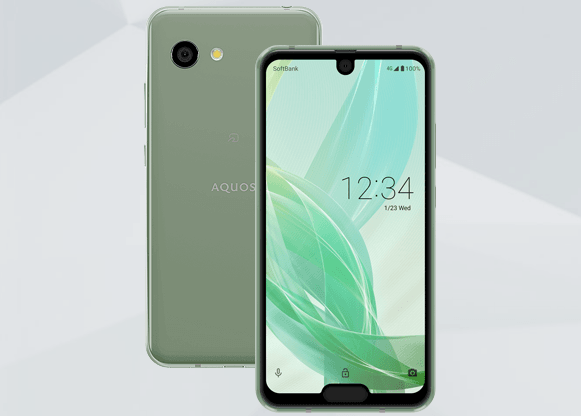Notches are a relatively new thing in the smartphone world, and as with all new features, we are now starting to see the evolution of the notch as well. Sharp has showcased the new Aquos R2 Compact, which has two notches.
Sharp’s Aquos R2 Compact features impressive specs
Sharp’s Aquos R2 Compact is a 5.2-inch handset. One notch is for the front 8-megapixel camera, while the other one is for the fingerprint reader at the bottom. The handset features a 2,280 x 1,080 120Hz display, 4 GB of RAM, 64 GB of expandable storage, and a Snapdragon 845 processor. Sharp’s Aquos R2 Compact uses indium, gallium, zinc and oxygen (IGZO) display tech, resulting in higher resolutions and less power consumption.
Further, the rear camera is 22.6 megapixels with an f/1.9 aperture, while the phone has a 2,500 mAh battery. It runs on Android Pie and supports Face Unlock. It also has a headphone jack and is water resistant, and it supports fast charging via the USB-C port. Its dimensions are 131 x 64 x 9.3 mm, while it weighs 135 grams.
Specs-wise, the Aquos R2 Compact is a decent upper mid-range device. The handset will be available in a unique “smoky” green color. Sharp has not revealed pricing details of the phone.
In Japan, the handset will be available in mid-January and will be sold by Softbank. The company is also expected to launch an unlocked version of the handset. Whether or not it will be released outside of Japan is not known, but the company rarely launches its smartphones outside its home market.
The notches look weird and make little sense
The top notch, which resembles a water drop, is similar to the one on the Essential Phone, while the bottom, much wider notch is similar to the one on the Honor 10. In addition to acting like a fingerprint sensor, the bottom notch also works like a home button. It can read gestures also. Users can swipe left or right on the bottom notch to access recent apps and return to the last opened screen.
By including more than one notch, Sharp has tried to optimize the available screen space, but the phone looks rather strange because the symmetry is broken on both ends of the display. Moreover, the reason for putting a bottom notch does not make much sense. Sharp could have easily placed the bottom notch on the back of the phone to save space on the front.
It will be interesting to see how the bottom notch accommodates videos, images and apps. However, Sharp is confident that the bottom display notch won’t affect app compatibility. Even Android 9 Pie supports two notches.
Not the first time for two notches… sort of
Sharp may not be the first manufacturer to imagine a phone with more than one notch. In April, ZTE showcased a concept phone with two notches. Dubbed the “ZTE Iceberg,” the handset featured a pair of notches and a glass adornment on the chassis. The chassis was notably a single-glass unibody, giving the glass corners an icy look.
Though Sharp and ZTE added two official notches to their phones, some of Google’s Pixel 3 devices also have more than one notch, although the second one is an accidental addition to some Pixel 3 XL devices, possibly due to a software bug.
So my Pixel randomly grew another notch today. ? https://t.co/c6Pff9MVmW pic.twitter.com/ugjfLmCkDZ
— UrAvgConsumer (@UrAvgConsumer) October 24, 2018
Many Pixel 3 XL owners have reported seeing two notches on the screen, with the second one appearing on the side of the screen. Google has acknowledged the issue and assured users of a fix.
This year has been the year of notches. The Essential Phone was the first phone to come with a notch. However, the concept gained popularity after Apple introduced the notch in the iPhone X last year. This year many more smartphone makers added a notch to their flagship and mid-range phones, like Huawei, Xiaomi, LG, OnePlus, OPPO, Vivo, Google, HMD Global and more.
The notch has become a necessity if smartphone makers want to give their devices a full-screen display. There are other options as well, like display sliders, popup cameras, or an under-screen front camera, but these options have yet to go mainstream. Samsung is the only major manufacturer to avoid notches so far, and it is expected to adopt an under-screen front camera for its upcoming phone.





